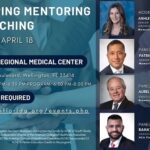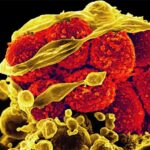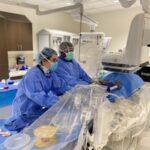While the clot-busting drug, tPA, has been the gold standard to treat stroke for decades, researchers from Florida Atlantic University’s Schmidt College of Medicine and Boca Raton Regional Hospital’s (BRRH) Marcus Neuroscience Institute are taking treatment options to the next level.
Jang-Yen (John) Wu, Ph.D., distinguished professor of biomedical science in FAU’s Schmidt College of Medicine, and Brian Snelling, M.D., chief of cerebrovascular and endovascular neurosurgery and medical director of the Marilyn and Stanley Barry Center for Cerebrovascular Disease and Stroke at the Marcus Neuroscience Institute and BRRH, have joined forces to combine a breakthrough interventional procedure for stroke with a novel drug compound that has neuroprotective properties.
At BRRH’s Marcus Neuroscience Institute, Snelling performs a procedure called a mechanical thrombectomy. He uses a stent within the walls of the artery to retrieve and remove blood clots in stroke patients. This method significantly reduces stroke-related disability and death, and one out of every two patients can walk out of the hospital after they have the procedure. Snelling likens it to the equivalent of giving antibiotics to a patient with pneumonia. However, time is of the essence.
That’s where Wu’s drug discovery efforts could make all the difference and give Snelling a wider timeframe to perform this procedure while protecting patients against further damage from blockages. Wu has been developing a therapeutic method to replenish new brain cells using granulocyte colony-stimulating factor (GCSF), an FDA-approved drug used to enhance blood cellular development. The idea is to administer GCSF during a mechanical thrombectomy directly to the site of the blockage, providing a more specific method of drug delivery right to the target. Wu and Snelling anticipate that this method could be very effective because GCSF would go directly to the site of damage.
GCSF could be a powerful growth factor because of its ability to preserve the central nervous system, suppress cell death and at the same time elicit neurogenesis as well as angiogenesis. GCSF works the same way for other neurological diseases such as Parkinson’s disease due to its neuroprotective properties.
“Dr. Wu’s discoveries have the potential to deliver pharmaceutical solutions to treat stroke in combination with Dr. Snelling’s cutting-edge interventional procedure,” said Daniel C. Flynn, Ph.D., FAU’s vice president for research. “The combination of their expertise could revolutionize the way we treat stroke patients and ultimately patients with other devastating neurological disorders like Parkinson’s disease and Alzheimer’s disease.”
Wu received a patent with the United States Patent Office (USPTO) for the neuroprotective properties of GCSF in stroke. A patent application with the USPTO also has been filed for the neuroprotective and neurogenesis properties of GCSF gene therapy for treatment of stroke and Alzheimer’s disease.
Wu and Snelling are working with South Florida-based CHS Pharma, Inc., to further develop and commercialize GCSF and this new treatment method. Spearheaded by Stephen Chakoff, director and founder, CHS Pharma, Inc. has an intellectual property portfolio for potential treatments related to ischemic stroke, dry macular degeneration and other age-related disorders such as Alzheimer’s disease. They have demonstrated efficacy in the basic science and preclinical work for GCSF and want to move the research to the next phase – small-scale clinical trials. Wu and Snelling both serve on the company’s scientific advisory board.
“This already FDA-approved drug has been successfully used with very few side effects for patients who require bone marrow transplants to stimulate blood cell formation,” said Wu. “This is actually the reason why I thought GCSF also could be used for neurogenesis. It’s the same principle and we proved that years ago. Now, we have a new indication to use this drug and to test its efficacy in combination with a mechanical thrombectomy.”
Stroke is the third leading cause of death and disability in the U.S., with one person dying every four minutes. Nearly 800,000 people have a stroke each year and about 87 percent are ischemic strokes, where blood flow to the brain is constrained or clogged. While there have been significant strides made in stroke research as well as major advances in stroke care, effective treatments are still insufficient and require a continued quest for new remedies.
“Boca Raton Regional Hospital and our Marcus Neuroscience Institute excel at delivering cutting-edge clinical care,” said Snelling. “We have partnered with Florida Atlantic University and John Wu to expand the scope of our work utilizing their vast research experience. We are excited about combining our expertise to potentially benefit patients by preventing further damage or the recurrence of a second stroke using a drug that is already available on the market.”
About the Charles E. Schmidt College of Medicine:
FAU’s Charles E. Schmidt College of Medicine is one of approximately 152 accredited medical schools in the U.S. The college was launched in 2010, when the Florida Board of Governors made a landmark decision authorizing FAU to award the M.D. degree. After receiving approval from the Florida legislature and the governor, it became the 134th allopathic medical school in North America. With more than 70 full and part-time faculty and more than 1,300 affiliate faculty, the college matriculates 64 medical students each year and has been nationally recognized for its innovative curriculum. To further FAU’s commitment to increase much needed medical residency positions in Palm Beach County and to ensure that the region will continue to have an adequate and well-trained physician workforce, the FAU Charles E. Schmidt College of Medicine Consortium for Graduate Medical Education (GME) was formed in fall 2011 with five leading hospitals in Palm Beach County. In June 2014, FAU’s College of Medicine welcomed its inaugural class of 36 residents in its first University-sponsored residency in internal medicine and graduated its first class of internal medicine residents in 2017.
About Boca Raton Regional Hospital – Advancing the Boundaries of Medicine:
Boca Raton Regional Hospital is an advanced, tertiary medical center (BRRH.com) with 400 beds, 2,800 employees and more than 800 primary and specialty physicians on staff. The Hospital is a recognized leader in Oncology, Cardiovascular Disease and Surgery, Minimally Invasive Surgery, Orthopedics, Women’s Health, Emergency Medicine and the Neurosciences, all of which offer state-of-the-art diagnostic and imaging capabilities. The Hospital is a designated Comprehensive Stroke Center by the Florida Agency for Health Care Administration (AHCA). BRRH is recognized in U.S. News & World Report’s 2018 – 2019 Best Hospitals listing as a Top Ranked Regional Hospital, for the fourth consecutive year, and the highest ranked hospital in Palm Beach County.
About Florida Atlantic University:
Florida Atlantic University, established in 1961, officially opened its doors in 1964 as the fifth public university in Florida. Today, the University, with an annual economic impact of $6.3 billion, serves more than 30,000 undergraduate and graduate students at sites throughout its six-county service region in southeast Florida. FAU’s world-class teaching and research faculty serves students through 10 colleges: the Dorothy F. Schmidt College of Arts and Letters, the College of Business, the College for Design and Social Inquiry, the College of Education, the College of Engineering and Computer Science, the Graduate College, the Harriet L. Wilkes Honors College, the Charles E. Schmidt College of Medicine, the Christine E. Lynn College of Nursing and the Charles E. Schmidt College of Science. FAU is ranked as a High Research Activity institution by the Carnegie Foundation for the Advancement of Teaching. The University is placing special focus on the rapid development of critical areas that form the basis of its strategic plan: Healthy aging, biotech, coastal and marine issues, neuroscience, regenerative medicine, informatics, lifespan and the environment. These areas provide opportunities for faculty and students to build upon FAU’s existing strengths in research and scholarship. For more information, visit fau.edu.

























